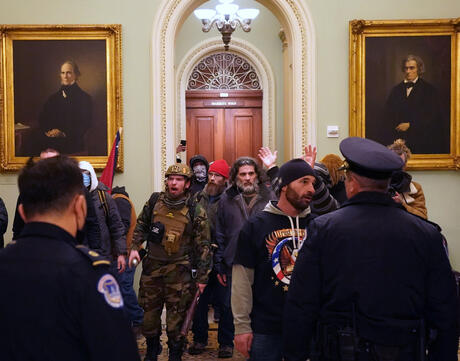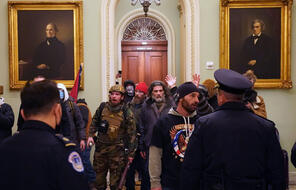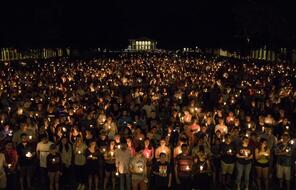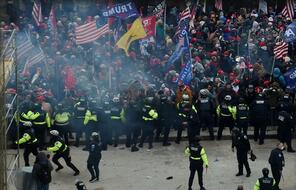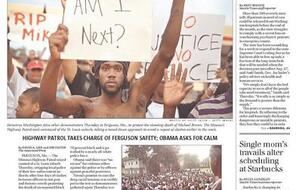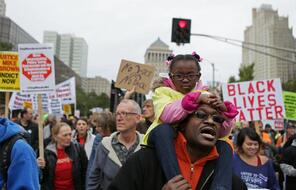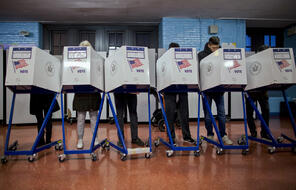In this activity, students brainstorm ideas for the lower portion of their iceberg diagrams and use the Big Paper teaching strategy to read, annotate, and reflect on a selection of sources that explore various causes underlying the insurrection. You can use the sources listed at the end of this activity or others of your choice.
Ask your students to write the following question “below the surface” of their iceberg diagrams:
What were the causes of the insurrection that took place at the US Capitol?
Then, ask your students to return to their small groups, brainstorm answers to the question, and write them next on the lower portion of their iceberg diagrams.
Once students have finished, explain to them that they will now complete a Big Paper activity that will help them learn more about the causes of the January 6 insurrection. Assign each group one source to begin the Big Paper activity. Students can use the following questions to help them reflect on their source:
- How do the ideas and information in this source connect to what you already know about the insurrection? What new ideas does this source raise?
- Is there anything in this source you find surprising or troubling?
- What questions does this source raise for you?
Once students have finished with their first source, ask them to read and comment on other groups’ sources. Once students have read and annotated every source, ask them to return to their iceberg diagrams and write down additional causes they learned about as well as their remaining questions.
Ask each group to share one of the causes they wrote down and record their responses on your shared class iceberg diagram. You can also record any remaining questions students have on a separate section of the board or paper and continue to revisit these questions over the coming days or weeks as new information about the insurrection emerges.
Sources for Big Paper Activity
Source 1: Excerpt from Adam Serwer’s article in The Atlantic, The Capitol Riot Was an Attack on Multiracial Democracy, January 7, 2021
The Washington Post described the insurrectionists who stormed the Capitol as “would-be saboteurs of a 244-year-old democracy.” But true democracy in America is only 55 years old, dating to 1965, the year the Voting Rights Act guaranteed suffrage—at least on paper—to all American citizens, regardless of race. Four decades later, a multiracial coalition elected a Black president. As in the past, the rise of Black men to political power made some white Americans question the wisdom of democracy.
That president’s successor, and many of his supporters, now insists that he must be allowed to remain in power despite having lost his reelection campaign, arguing that his opponent’s victory is illegitimate regardless of the results, and demanding that votes from predominantly Black constituencies in swing states be thrown out. As Trump put it, “Detroit and Philadelphia—known as two of the most corrupt political places anywhere in our country, easily—cannot be responsible for engineering the outcome of a presidential race.” Presenting the disenfranchisement of Black Americans as an exercise in good government is one of the most recognizable constants of American history.
Although these arguments by definition involve rejecting the results of a democratic contest, those who insist that Trump remain in office see themselves as defending democracy by disregarding votes that were never meant to count. Like most of the political ills that Trump has brought to the fore, this one predates him by many years, and has found a home in both political parties at one point or another.
Source 2: Excerpt from the RAND report Truth Decay: An Initial Exploration of the Diminishing Role of Facts and Analysis in American Public Life, 2018
In many areas of American society, facts and data are essential to survival or necessary for success. Complex decisions, even when they require subjective judgments and intuition, can be made with more confidence when anchored by agreed-upon facts and reliable data. Yet in national political and civil discourse, disagreement over facts appears to be greater than ever. Opinions are crowding out and overwhelming facts in the media, and Americans are placing less faith in institutions that were once trusted sources of information. This shift away from facts and data in political debate and policy decisions has far-reaching implications: It erodes civil discourse; weakens key institutions; and imposes economic, diplomatic, and cultural costs.
Source 3: Excerpt from Rebecca Heilweil and Shirin Ghaffary’s article in Vox, How Trump’s internet built and broadcast the Capitol insurrection, January 8, 2021
For years, members of movements like QAnon, the Proud Boys, and the Three Percenters, a far-right militia group—not to mention hordes of white supremacists and conspiracy theorists—have been allowed to accumulate and grow on platforms like Facebook, YouTube, and Twitter. While the mainstream social networks have taken action to restrict and even ban the groups, many had already achieved a significant level of organization, leaving critics to say that the crackdown came too late.
“Social media platforms, for years, have allowed their algorithms to boost disinformation and far-right organizing,” said Fadi Quran, campaign director at the human rights group Avaaz. “In DC, we saw QAnon conspiracists and other militias that would never have grown to this size without being turbo-charged by Facebook and Twitter.”. . .
Violent events like the “Unite the Right” rally in Charlottesville, the attack at the Christchurch mosque, and the Pittsburgh synagogue shooting often have their roots in anger and bigotry that festers online. It’s also undeniable that Trump and his high-profile followers have become instigators. By spreading misinformation and false claims that the election was stolen — and by giving tacit approval to groups like QAnon and the Proud Boys — Trump’s online rhetoric excited his base and encouraged the storming of the Capitol.
Source 4: Excerpts from President Trump’s speech on January 6, 2021, and analysis from Charlie Savage’s article in the New York Times Incitement to Riot? What Trump Told Supporters Before Mob Stormed Capitol
Excerpts from Trump’s speech:
We will never give up. We will never concede. It doesn’t happen. You don’t concede when there’s theft involved.
Our country has had enough. We will not take it anymore, and that is what this is all about.
And to use a favorite term that all of you people really came up with, we will stop the steal.
. . . and we fight, we fight like hell, and if you don't fight like hell you're not going to have a country anymore . . .
So we are going to--we are going to walk down Pennsylvania Avenue, I love Pennsylvania Avenue, and we are going to the Capitol, and we are going to try and give--the Democrats are hopeless, they are never voting for anything, not even one vote but we are going to try--give our Republicans, the weak ones because the strong ones don't need any of our help, we're try--going to try and give them the kind of pride and boldness that they need to take back our country. So let's walk down Pennsylvania Avenue.
Analysis from the New York Times:
The president’s speech was riddled with violent imagery and calls to fight harder than before . . .
Two months after he lost the election, Mr. Trump repeatedly told his followers that they could still stop Mr. Biden from becoming president if they “fight like hell,” a formulation that suggested they act and change things, not merely raise their voices in protest.
Source 5: Excerpt from Taymullah Abdur-Rahman’s op-ed in the Boston Globe, Protected by an invisible bullet-proof vest called white skin, January 7, 2021
I’m relieved that large numbers of American civilians weren’t gunned down by law enforcement under the guise of protecting the symbols of freedom and democracy. However, I’d be remiss not to mention that those Trump supporters who barged their way into the Capitol and took an armed stance were being protected by an invisible bullet-proof vest called white skin.
Although indiscriminate violence did not win the day, those who would have their country burn to the ground rather than acquiesce to the democratic process did retain the small, albeit significant, victory of expressing their rage and angst to an extreme degree and toward the highest level of government without much punitive outcome. In an America where, just two weeks ago, a Black man, Andre Hill, was shot down in a driveway by police, in Columbus, Ohio, while dropping off Christmas money to a friend, this is a huge problem.
